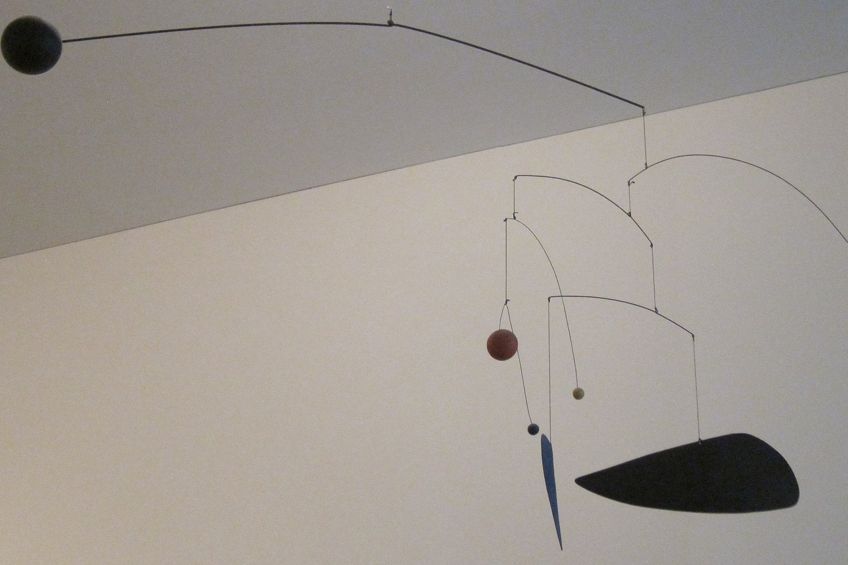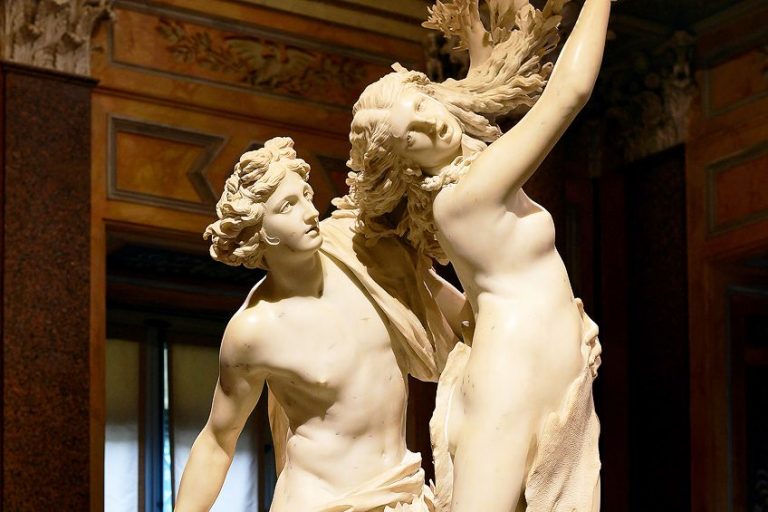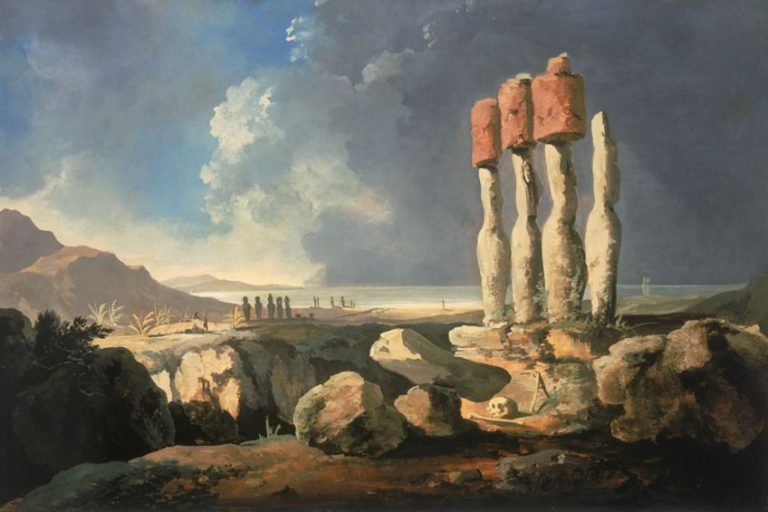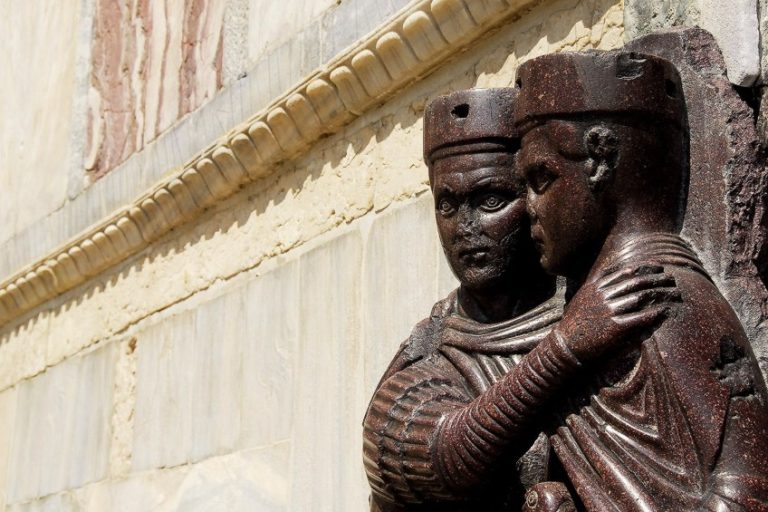“Mobile” by Alexander Calder – A Kinetic Art Analysis
Alexander Calder has become synonymous with moving sculptures, or as they are famously known, mobiles. He epitomized movement in art and made it playful and abstract. His art was diverse and moved in a myriad of fashions, both figuratively and literally, in the air and on land. Some also stood still. The article below will discuss Calder’s art further, with a focus on one moving example titled Mobile (c. 1932).
Artist Abstract: Who Was Alexander Calder?
Alexander Calder was born on July 22, 1898, and died on November 11, 1976. His city of birth was Lawnton, Pennsylvania and he died in New York City of a heart attack. He was from an artistic family and created sculptures from a young age. Some of his formal studies included engineering at the Stevens Institute of Technology from 1915 to 1919 and he also studied at the Art Students League in 1923. He had numerous exhibitions throughout his artistic career, some of his commissions included a sculpture for UNESCO and he had collaborations all over the world. Some of his works include Calder’s Circus (1926 – 1931), Arc of Petals (1941), and Red Mobile (1956).

Mobile (c. 1932) by Alexander Calder in Context
| Artist | Alexander Calder (1898 – 1976) |
| Date Painted | c.1932 |
| Medium | Wire, string, metal, and wood |
| Genre | Mobile sculpture |
| Period/Movement | Kinetic Art |
| Dimensions (Millimeters) | 1500 x 2000 x 2000 mm (unconfirmed) |
| Series/Versions | N/A |
| Where Is It Housed? | Tate Modern, London, United Kingdom |
| What It Is Worth | The price is uncertain, but it was reportedly obtained by Julian Trevelyan during the earlier 1930s, and has been on loan to the Tate since 1992. |
This article will discuss a contextual analysis of Alexander Calder’s artistic oeuvre and how he started his sculptural style. Although there will be mention of other examples of his artworks, however, the formal analysis below will focus on and discuss one specific mobile sculpture by Calder, titled Mobile (c. 1932).
Contextual Analysis: A Brief Socio-Historical Overview
Alexander Calder created art from an early age, making small animal figure sculptures out of brass sheets, namely his Dog (1909) and Duck (1909). He reportedly made these during Christmas time that he gave to, or showed to, his parents, and even as early as his childhood he incorporated dynamism into his structures, like his Duck, which was built with the ability to rock forward and backward. This movement in artwork has also been termed “kinetic”.
Calder’s artistic oeuvre evolved over his lifetime, from making brass figurines to wire sculptures of people, for example, Struttin’ His Stuff (c. 1926) and Josephine Baker I (c. 1926), the latter of which he produced several wire sculptures. He also made animals, examples include, Bird (1927), Leopard (c. 1927), Mule (c. 1927), and Elephant (c. 1927).
He also utilized other materials, for example in his Cirque Calder (1926 – 1931), which consisted of small circus animals and figures that Calder created performances with, in Paris and New York, were made from materials like wire, wood, rubber, paper, bottle caps, string, corks, and more.
A Catalyst for Calder’s Mobiles
While Calder produced figurative artworks, he also delved into the abstract, and this was a turning point in his art career. A notable experience was when he visited Piet Mondrian’s art studio in Paris in 1930. Piet Mondrian was a Dutch artist, known for working in the art style called Neo-Plasticism and known for his geometric paintings that consisted of primary colors, squares, and rectangles, with bold black lines in between. An example includes his Composition with Red, Blue and Yellow (1930).
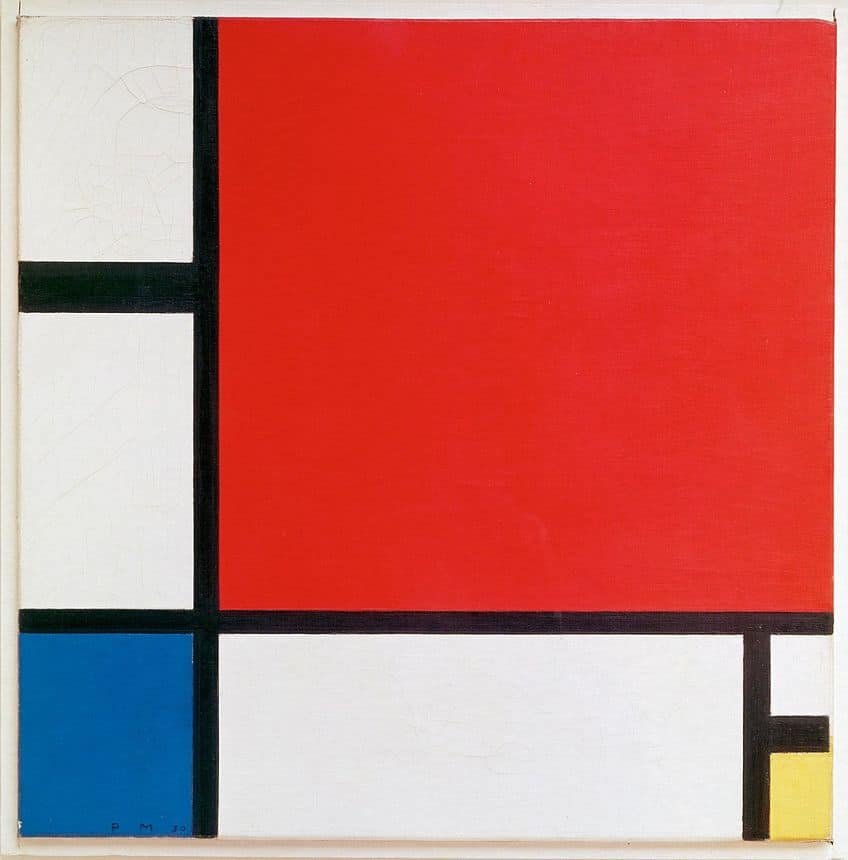
Alexander Calder spoke about his visit to Mondrian’s studio and how it caused a change in his desire to try abstract art. He said that “this one visit” gave him a “shock that started things”. He reportedly started painting in the abstract and stated that he reverted to “plastic” artworks that were also abstract.
Calder started making what was known as his mobiles, which were also motorized, but eventually, Calder created these that could move by other effects like touch or air blowing on it. Another turning point was when the famous “Readymade” and Dada artist, Marcel Duchamp, described Calder’s moving sculptures as “mobiles” when he saw them in 1931.
Additionally, the Dada artist, Jean Arp, in response, termed Calder’s stationary artworks “stabiles”.
Formal Analysis: A Brief Compositional Overview
The formal analysis below will focus on the Mobile sculpture by Alexander Calder to explore what techniques and media he utilized. The visual description will introduce the subject matter, which appears abstract, and this will lead to how the art elements create the piece.
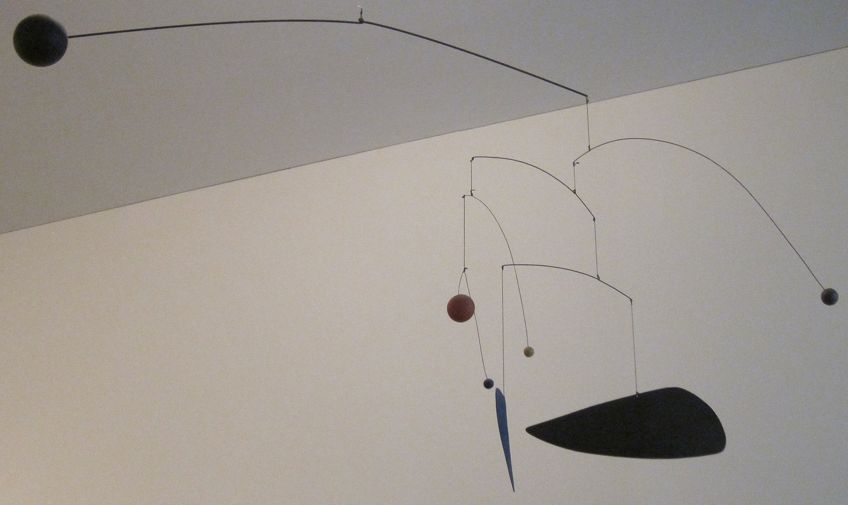
Subject Matter: Visual Description
Alexander Calder’s Mobile is a hanging mobile made from wire, string, wood, and metal. There are around six hanging tiers connected to one another by what appears to be wire and possibly a string. To bear in mind, as the mobile will turn and move, the orientations, in other words, what is left and right, will change, but for the purposes of this formal analysis, it will be viewed and described from the front angle.
The top tier is composed of a thicker curved wire, which is the main part from which the rest of the mobile hangs. There is a black ball attached to the left end of it and the right end has a thinner, and somewhat short, wire/string attached that hangs down and branches out into the rest of the mobile.
The second tier, so to say, is a vertical wire with a prominent curve at the upper end that leads downwards and is slightly angled outwards. There is a smaller, silver/gray ball attached to its end.
This hangs from a shorter and thinner wire/string that is attached to the third tier, which is a longer, thicker horizontal, and slightly convex, wire. At each end of this wire are shorter, thinner wires/strings where the other tiers of the mobile hang and extend.
At the left end of the third tier is a vertical, straight, and short, thin wire/string with an almost crescent-shaped thin wire hanging from it. This wire has a small yellow ball attached to its right end and at its left end is another vertical, straight wire with an irregularly curved wire attached to it. This wire has a medium-sized red ball at its right end and a small black ball at its left end.
At the right end of the third tier is a vertical, straight wire/string that hangs down where another slightly convex-shaped wire hangs. From both ends of this wire are vertical, thinner, and straight wires/strings hanging down. The left side has an irregularly-shaped dark blue form attached to it and the right side has a black form attached to it.
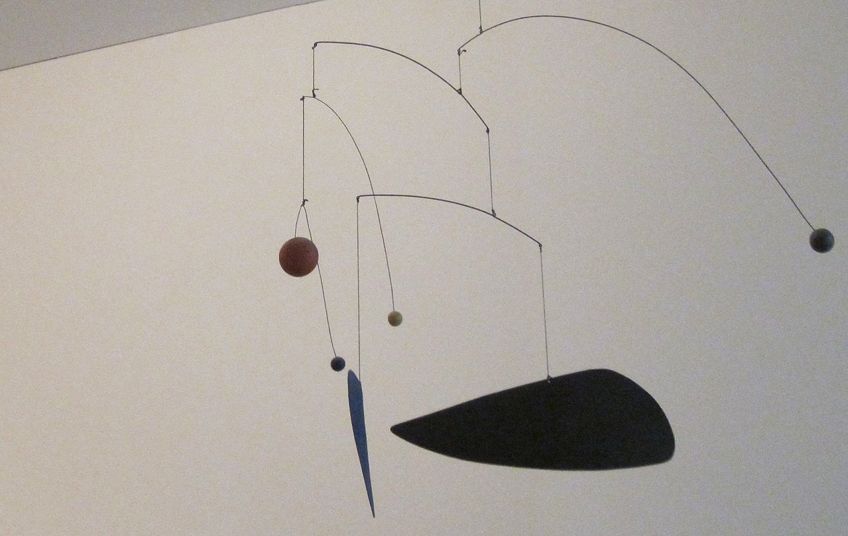
Color
Alexander Calder utilized primary colors, yellow, blue, and red in his Mobile. These are on the hanging shapes, namely two of the balls and one of the irregular flat shapes. The other, more dominant colors are neutral, mainly black and gray/silver.
The colored shapes create a contrast amidst the monotones.
Texture
The Mobile sculpture is tangible in its texture due to its three-dimensionality. The dangling shapes have smooth surfaces and there appear to be some paintbrush marks on the flatter, irregular dark blue and black shapes near the bottom of the mobile.

Line
The type of lines in Mobile by Alexander Calder are dynamic, contrasting, and varied. These are all created by the actual materials of the mobile structure. For example, there are thick, thin, straight, curved, round, and diagonal lines visible.
These are created from wires/strings and hanging shapes.
Shape and Form
Due to the abstract quality of Alexander Calder’s Mobile, the type of shapes and forms are more geometric with some organic and irregular forms too. Examples include the spherical forms of the five balls and the irregular shapes of the two flatter, dark blue and black, shapes.
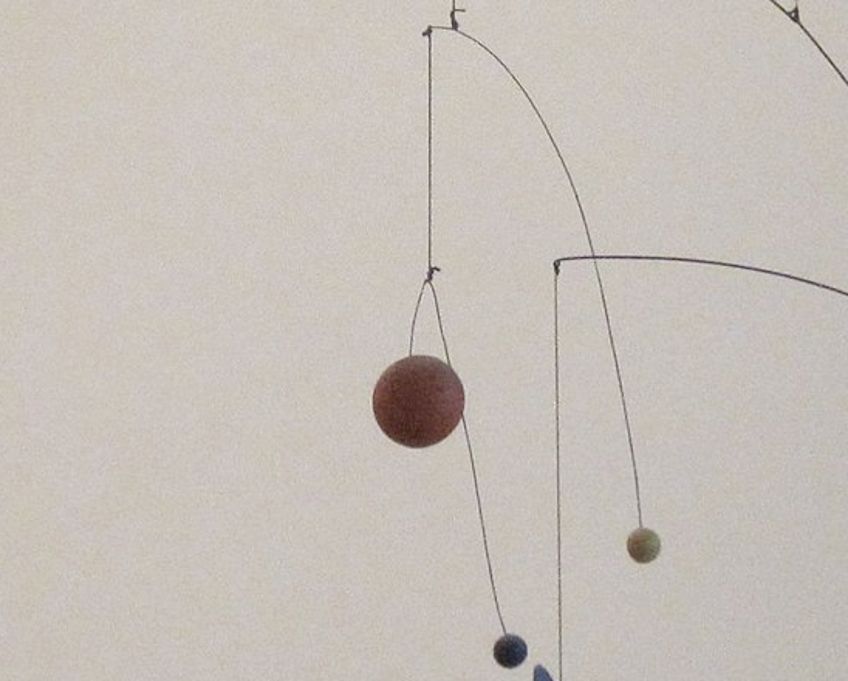
Space
Alexander Calder’s Mobile occupies a three-dimensional space, it can be viewed as being the positive space, and the space around and in between it can be considered as the negative space. We, the viewers, can also interact with the mobile in a more physical and dynamic manner, in other words, we can walk around it or make it move around.
This is contrasted to more two-dimensional canvases, where the viewer is only able to stand in front of the canvas and look at the image.
Calder’s Moving Mobiles
From small sculptures to completely larger-than-life monuments, you can find Calder’s mobiles adorning public spaces like the John F. Kennedy International Airport in New York City, the Pittsburgh International Airport in Pennsylvania, the central court of the National Gallery of Art’s East Building in Washington, or the plaza by the City Hall in the Grand Rapids in Michigan. These are only a few examples of the heights Calder’s mobiles have achieved.

This article discussed Mobile by Alexander Calder, an asymmetrical yet balanced structure that allows complete movement around it, or under it. It is one of the hundreds of the artist’s dynamic artworks that have occupied and enlivened a space, and through its own dynamism, it motivates mobility in those who interact with it.
Alexander Calder’s artworks were depicted in two and three dimensions and ranged from geometric to organic, hanging to standing, and even motorized. His art was a visual testament to his love of creating, and movement was seemingly always the breath that gave Calder’s artwork life.
Frequently Asked Questions
Who Created the Mobile Sculptures?
The American sculptor, Alexander Calder, created the famous mobile sculptures. These appear in varieties of different shapes and forms that he created to be able to move around instead of standing still.
What Inspired Alexander Calder’s Mobiles?
Alexander Calder was inspired by the Neo-Plasticism artist, Piet Mondrian, and his abstract compositions when he visited his studio. Calder constructed moving pieces that resembled Mondrian’s geometric paintings.
Where Did the Term Mobile Come From?
The French artist, Marcel Duchamp, reportedly came up with the so-called term mobiles when he described Alexander Calder’s moving sculptures. This was reportedly in 1931 when Duchamp visited the studio of Alexander Calder.
Alicia du Plessis is a multidisciplinary writer. She completed her Bachelor of Arts degree, majoring in Art History and Classical Civilization, as well as two Honors, namely, in Art History and Education and Development, at the University of KwaZulu-Natal, South Africa. For her main Honors project in Art History, she explored perceptions of the San Bushmen’s identity and the concept of the “Other”. She has also looked at the use of photography in art and how it has been used to portray people’s lives.
Alicia’s other areas of interest in Art History include the process of writing about Art History and how to analyze paintings. Some of her favorite art movements include Impressionism and German Expressionism. She is yet to complete her Masters in Art History (she would like to do this abroad in Europe) having given it some time to first develop more professional experience with the interest to one day lecture it too.
Alicia has been working for artincontext.com since 2021 as an author and art history expert. She has specialized in painting analysis and is covering most of our painting analysis.
Learn more about Alicia du Plessis and the Art in Context Team.
Cite this Article
Alicia, du Plessis, ““Mobile” by Alexander Calder – A Kinetic Art Analysis.” Art in Context. September 21, 2023. URL: https://artincontext.org/mobile-by-alexander-calder/
du Plessis, A. (2023, 21 September). “Mobile” by Alexander Calder – A Kinetic Art Analysis. Art in Context. https://artincontext.org/mobile-by-alexander-calder/
du Plessis, Alicia. ““Mobile” by Alexander Calder – A Kinetic Art Analysis.” Art in Context, September 21, 2023. https://artincontext.org/mobile-by-alexander-calder/.


